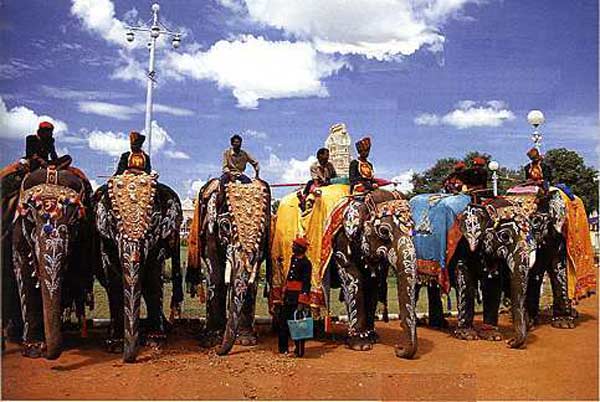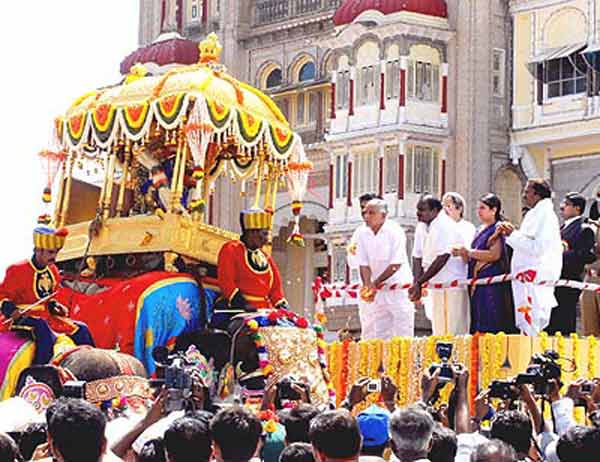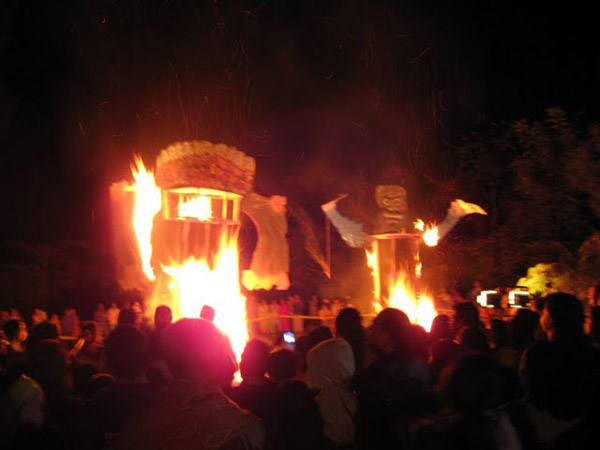Dasara Festival
Dussehra -Karnataka |
About: |
| One of the major festivals of the Hindus celebrated with great pomp and festivities is the Dussehra. The Dussehra Festival in Karnataka is a 10 day carnival that was once celebrated with a lot of extravagance by the Vijayanagara Empire in Karnataka, once the greatest Empire ruling the south. Later, these festivities became a part of the tradition of the Hindu religion. The Dussehra is mainly celebrated in Mysore which is one of the most important and well known Dussehra festivals in India. This festival in celebrated to mark the defeat of Ravana by Lord Rama.
The 10 day festival of Dussehra in Karnataka is mainly held in Mysore where the royal family of Mysore has a major and significant contribution. The most important feature of the celebrations of Dussehra is the 'Dussehra Procession' that is held on the Vijayadashami or the tenth day of the festival. There are lavishly decorated elephants that carry the idol of Chamudeswari which is places on a golden seat on the elephant. They are accompanied by horses, folk dancers, courtiers, nobles, soldiers and visitors, all of whom together displays a colorful sight. The Dussehra celebrated royally in Mysore, Karnataka, include regal processions, torch light parades and musical events. In many parts of India Dasara is known as Navratri. In Karnataka Dasara is celebrated in the month of October with great festivity. People from all over the state take part in this amazing festival. Mysore is the city of silk and sandalwood and till date it remains the center for traditions, culture and art. The city is often referred to as the `City Royale` and Dasara is considered to be a Royal festival celebrating the victory of good over evil. In Karnataka Dasara is celebrated as Nadahabba. The celebration has its roots in the royal family of Mysore. They perform a special puja during this festival. As a part of Navratri or the festival of nine nights Dasara is the last day of the festivity. In other parts of India it is also called Vijayadashami. According to legends on this day Goddess Chamundeshwari killed Mahishasura, the demon king. The name Mysore has been derived from his name. Dasara celebrates this auspicious moment. It is commonly believed that the goddess (Shakti) is the most powerful during this time. Hence rituals are also performed to appease Her. |
Location info: |
| Address: Dussehra,Karnataka,India |
| District: Karnataka,India |
| Best time to visit: Month of October |
Climate/Weather: |
| During winter temperatures range from 32 degrees Celsius to below 20 degrees Celsius,Summer Average temperature is 34 degrees Celsius |
History: |
| The history of Dasara festival in Karnataka dates back to 15th century. It was the Wodeyars of Mysore who followed the tradition of celebrating Dasara. During their time the puja used to be held in the Chamundi Temple located on a hilltop. Today on this day a procession is taken out on the city streets. The decorated idol of the goddess is placed on an elephant back. Before going out on the streets the idol is worshipped by the royal couple. Dance groups, decorated horses, elephants, camels, music bands and colorful pictures are also a part of this procession. |
Importance: |
| Entire Karnataka celebrates Dasara every year. The custom of worshipping dolls - Gombe Tottilu - is actually a symbolic representation of a darbar or a court. Not long back women made a huge fuss over the Gombe decoration and planned months ahead. For many women it was an opportunity to showcase their talent. Singing, dancing and merry making along with showing off their skills at preparing the Gombe Bagina was all very important.Woman is a synonym with womb and earth. The harvest season begins at this time and the earth is invoked to start afresh the new harvest season and to reactivate the vigour and fertility of the soil by performing religious rituals which is believed to invoke the cosmic forces. Hence the importance of Devi worship for women.
|
Method of Celebration: |
|
Royal Style: Celebrating Chamundeshwari: Worship: |
Culture of Festivities: |
| One derivation of the word Dasera is from dashhara. 'Dash' means ten and 'hara' means defeated. Nine days before Dasera, in the nine days of Navaratri, all the ten directions are saturated with the female deity's devi's-Shakti energy. 'Shakti' has control over creation in all the ten directions dikbhav , attendants (gan), etc. That is why this day is known as Dashhara, Dasera, Vijayadashami, etc. This is one amongst the three and a half auspicious moments (muhurts) of the year. This falls on the tenth day (dashami) of the bright fortnight of Ashvin. The immersion of the Navratri female deity is done on the ninth day navami or the tenth day. Four rituals namely crossing the territory (Simollanghan), worship of the Shami tree Shamipujan , worship of the deity Aparajita aparajitapujan and worship of instruments Shastrapuja should be performed on this day. |
How to reach? |
| Nearest Railway Station: |
| Nearest Airport: |
| Road Transport: |
Hotels/Lodge/Accommodation: |
Help Line/Phone Number: |
| Police Station:100 |
| Nearest Hospital: |
| Society/Community Phone Number: |
| Link: |













